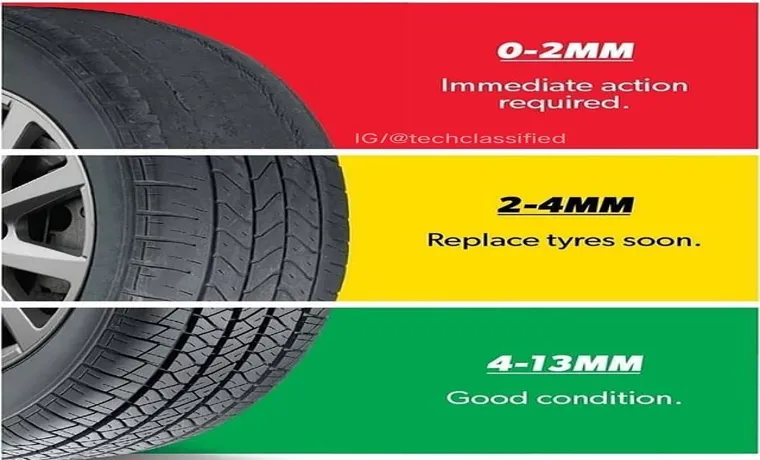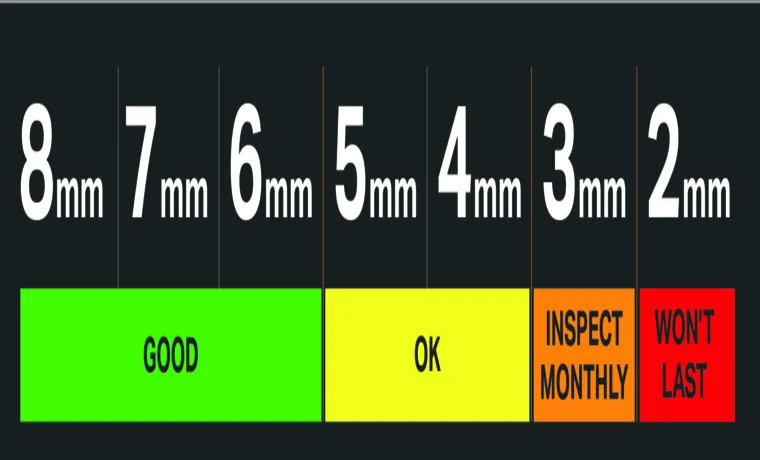Have you ever wondered whether your tires are safe to drive on? You’re not alone. In fact, one of the most common questions we get is “What is the minimum acceptable tire tread depth in California?” It’s an important question because tires play a critical role in your vehicle’s safety. Your tires are the only point of contact between your car and the road, and without proper tread depth, they can’t perform their job properly.
In this blog post, we’ll explore everything you need to know about tread depth requirements, what the law says, and what you can do to ensure your tires are safe to drive on. Let’s get started!
Understanding Tire Tread Depth
When it comes to driving safely in California, ensuring that your tires are in good condition is crucial. Specifically, it’s important to have an adequate amount of tire tread depth to ensure proper traction on the road. The minimum acceptable tire tread depth in California is 2/32 of an inch, which is roughly the width of a paperclip.
This standard is in place to ensure that your tires can provide sufficient grip on both wet and dry roads. It’s important to regularly check your tire tread depth and replace your tires if they fall below this minimum threshold. This will not only help you stay safe on the road but also avoid potential legal consequences for driving with unsafe tires.
Why is Tire Tread Depth Important?
Tire tread depth is incredibly important when it comes to vehicle safety. This refers to how much of the rubber on the tire’s surface remains between the grooves. The more tread depth a tire has, the better its ability to grip the road, especially during wet or slippery conditions.
When the tread wears down to a certain level, the tire’s ability to maintain traction decreases, which can be incredibly dangerous. In fact, driving on bald or nearly bald tires is illegal in most states. One way to check the tread depth yourself is to insert a penny into the grooves of the tire with Lincoln’s head facing down.
If you can see the top of Lincoln’s head, it’s time to replace your tires. By regularly checking your tire’s tread depth, you’ll be able to maintain their performance and your safety on the road.

How is Tire Tread Depth Measured?
Tire tread depth is a crucial factor that affects the performance and safety of your vehicle. To measure the tread depth, you can use a tire tread depth gauge or a penny. The tire tread depth gauge is a small handheld tool that gives you an exact measurement of your tire’s depth.
On the other hand, the penny test is a simple and quick way to check your tire’s tread depth on your own. To perform the test, place a penny upside down in one of your tire’s grooves. If you can see the top of Lincoln’s head, your tire has less than 2/32 inches of depth and needs replacing.
It’s recommended to check your tire tread depth monthly and also before any long trip. A worn-out tire can cause various problems that include hydroplaning and poor braking performance. So, keep an eye on your tire’s tread depth and replace them when necessary to ensure your safety and performance on the road.
California’s Minimum Acceptable Tire Tread Depth
If you’re driving in California, it’s important to make sure that your tires are roadworthy, which means that they’re in good condition with enough tread depth to ensure proper traction on the road. The minimum acceptable tire tread depth in California is 2/32 of an inch. This means that the tire’s tread depth should not be less than 2/32 of an inch in any grooves around the tire’s circumference.
You can use a penny to check your tire’s tread depth. Insert the penny into the tire’s groove with Lincoln’s head facing downward. If you can see all of Lincoln’s head, your tread depth is less than 2/32 of an inch, which means that your tires are unsafe and need to be replaced.
Remember, it’s important to check your tire’s tread depth regularly to make sure that they’re in good condition and safe to drive on, especially during wet, slippery conditions.
What is California’s Minimum Acceptable Tire Tread Depth?
California’s minimum acceptable tire tread depth is 2/32 of an inch. This measurement is taken at the shallowest point in the tire’s tread and applies to all tires on a vehicle, including the spare. Maintaining proper tire tread depth is essential for ensuring safe driving conditions, particularly in rainy or slippery weather.
Worn tires can greatly increase the risk of accidents and decrease stability on the road. A good way to check tire tread depth is to use a penny. Insert the penny into the tread with Lincoln’s head facing down.
If you can see the top of Lincoln’s head, it’s time to replace your tires. It’s important to take good care of your tires by keeping them properly inflated, rotating them regularly, and checking them for damage or wear. Proper tire maintenance can ensure they last longer and keep you safer on the road.
Exceptions to California’s Minimum Acceptable Tire Tread Depth
California’s minimum acceptable tire tread depth is 1/32 inch for passenger cars and light trucks. However, there are some exceptions to this rule. For example, studded tires, which are designed for use in snowy or icy conditions, are allowed to have a minimum tread depth of 1/8 inch.
Additionally, spare tires that are intended for temporary use are also exempt from the minimum tread depth requirement. It’s important to note that while these exceptions may be allowed, it’s still advisable to maintain healthy tire tread for safety reasons. Tires with low tread can increase the risk of hydroplaning, reduce traction, and lead to longer stopping distances, particularly in wet or slippery conditions.
Regularly checking your tire tread depth and replacing your tires as needed can help keep you safe on the road.
Penalties for Having Insufficient Tire Tread Depth
If you’re driving on California roads, it’s crucial to keep your car’s tire tread depth within the minimum acceptable limit to avoid penalties. The law requires tire tread depth to be at least 2/32 of an inch across the tire’s tread surface. Having less than that can result in a $136 fine per tire, which can add up quickly if all four tires are worn out.
Driving on bald or worn-out tires can also be hazardous, decreasing traction and increasing the risk of hydroplaning, especially in wet conditions. It’s worth keeping an eye on your tire’s tread depth and regularly replacing them when necessary to avoid both financial and safety penalties. Remember, it’s not just a legal requirement, but it’s also a responsibility towards yourself and other motorists on the road.
Maintaining Adequate Tire Tread Depth
Do you know what the minimum acceptable tire tread depth is in California? Well, the state law requires tires to have a minimum tread depth of 2/32 of an inch. However, it is best to replace your tires before they reach this point to ensure your safety on the road. Your tires are one of the essential components of your vehicle that ensures proper handling, especially during inclement weather conditions, such as heavy rain and snow.
Balding tires can increase the risk of hydroplaning and sliding on slippery roads, and can also lead to blowouts, which can be dangerous for you and other road users. Therefore, it is crucial to keep an eye on your vehicle’s tire tread depth regularly and replace the tires when necessary. Remember, driving with worn-out tires is not worth the risk; it is better to be safe than sorry.
Checking Your Tire Tread Depth Regularly
Maintaining adequate tire tread depth is essential for safe driving. It is necessary to check your tire tread depth regularly, as worn-out tires can be extremely hazardous, especially in wet or slippery conditions. Tires with insufficient tread depth may compromise your vehicle’s performance, particularly in terms of braking and handling, and increase the risk of accidents.
One of the simplest ways to check your tire’s tread depth is through the use of a penny. Insert the penny into the groove of the tire. If you can see Lincoln’s head completely, your tire treads are too worn and require replacing.
Ensure you check all four tires, as they may wear out unevenly due to different driving conditions. Maintaining adequate tire tread depth is a simple yet crucial aspect of maintaining road safety. By doing so, you can drive with confidence and avoid unnecessary risks on the road.
Replacing Tires with Insufficient Tread Depth
Maintaining adequate tire tread depth is essential for safe driving. Tires with insufficient tread depth can result in poor traction and reduced stability, especially in wet or icy conditions. It’s important to monitor your tire tread depth regularly using a tread depth gauge and replace your tires when the tread depth reaches 2/32 of an inch or lower.
Driving on bald tires can increase the risk of hydroplaning, skidding, and even accidents. While replacing tires may seem costly, it’s a necessary investment in your safety on the road. Think of it as similar to maintaining the brakes on your car – necessary for safe operation.
Always prioritize safety and ensure your tires have enough tread depth to keep you and your passengers secure while driving.
Conclusion
In California, the answer to the age-old question of “how low can you go” when it comes to tire tread depth is not just a matter of preference or performance. The minimum acceptable tread depth of 2/32 of an inch is crucial for safe driving and ensuring that your tires meet state regulations. So, don’t wait until your tires are bald and your car is skidding out of control to replace them.
Remember, in California, keeping up with your tire game isn’t just about being stylish, it’s about staying safe and street legal.”
FAQs
What is the legal minimum tire tread depth in California?
The minimum legal tire tread depth in California is 1/32 of an inch.
How can I measure my tire tread depth?
You can measure your tire tread depth using a tread depth gauge or a penny. Insert the gauge or penny into the grooves of your tire and measure the depth.
Is it safe to drive with worn out tires in California?
No, it is not safe to drive with worn out tires in California as they can increase the risk of accidents and citations from law enforcement.
Are there any exemptions to the minimum tire tread depth requirement in California?
No, there are no exemptions to the minimum tire tread depth requirement in California.
How often should I check my tire tread depth?
You should check your tire tread depth at least once a month and before a long road trip.
What are the penalties for driving with worn out tires in California?
The penalties for driving with worn out tires in California can include fines and points on your driver’s license.
Can I replace only one tire if it has worn out tread?
While it is possible to replace only one tire if it has worn out tread, it is generally recommended to replace all four tires for optimal performance and safety.

